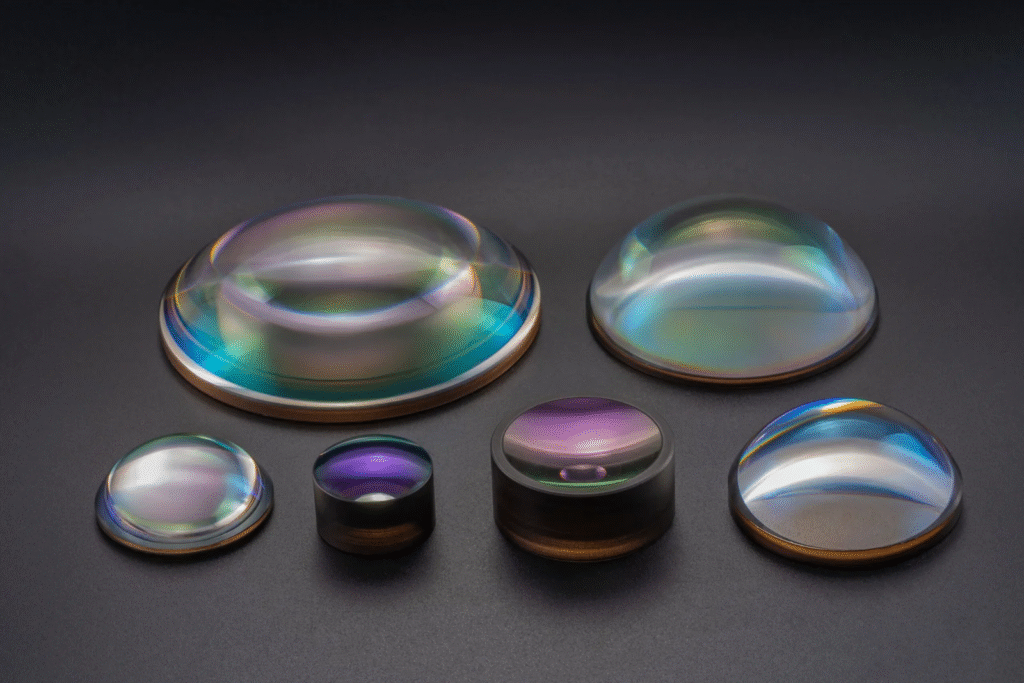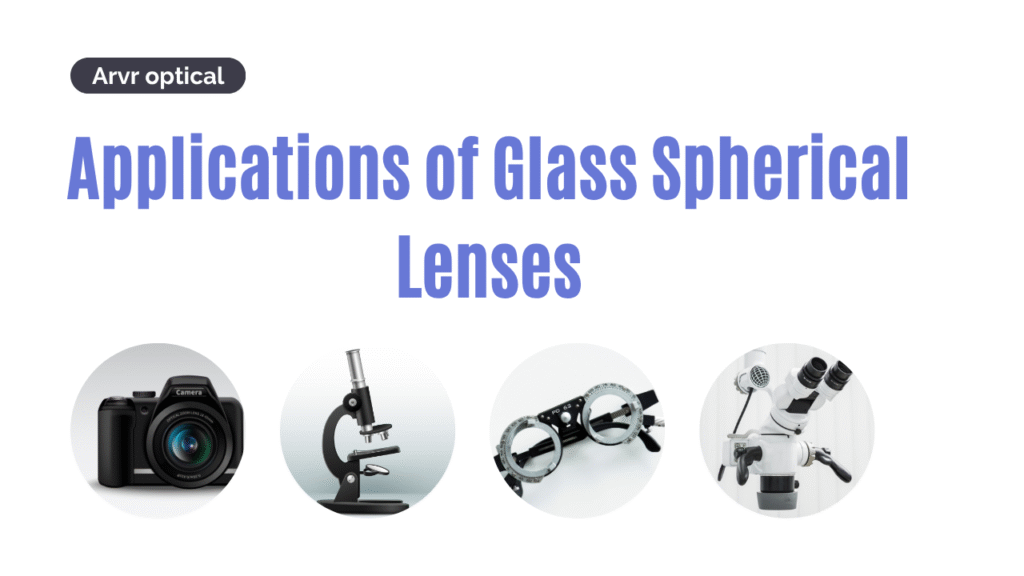A glass spherical lens is a curved optical lens made of high-quality glass, designed to bend and focus light. It has a smooth, ball-like shape that allows light rays to converge or diverge, creating clear and sharp images. These lenses are widely used in optical instruments like cameras, telescopes, microscopes, and eyeglasses due to their ability to control light effectively.
Unlike other advanced lens types, such as aspherical lenses, a glass spherical lens offers a simpler design that is easy to manufacture and highly durable. Its consistent curvature helps create reliable optical performance, making it suitable for everyday devices and scientific equipment. These lenses play a critical role in both imaging and projection technologies.
In this article, we will explore what a glass spherical lens is, how it works, and why it is essential in modern optics. You’ll also learn about its uses, benefits, and key differences from other lenses.
What is a Glass Spherical Lens?

A glass spherical lens is a transparent optical element with at least one surface shaped like part of a sphere. Depending on its curvature, it can converge or diverge light.
Main types
- Convex (converging) lenses
- Plano‑convex (PCX): one flat, one outward-curved surface
- Bi‑convex (DCX): both surfaces outward-curved
- Focus parallel light to a point (positive focal length)
- Concave (diverging) lenses
- Plano‑concave (PCV): one flat, one inward-curved surface
- Bi‑concave (DCV): both surfaces inward-curved
- Spread parallel light rays outward (negative focal length)
Typical materials
- BK7 (borosilicate crown) glass – economical, high transmission in visible range
- Fused silica – excellent UV transmission, low thermal expansion
- Fluorite / specialty glasses – lower dispersion for chromatic control
- High-index glasses – enable shorter focal lengths for compact systems
How Does a Glass Spherical Lens Work?
The key principle is refraction—light changes speed when it enters glass from air, causing it to bend at the interface. The spherical curvature controls how much the rays bend, and where they converge (focus) or appear to diverge from.
- Convex lenses bend rays inward toward the focal point.
- Concave lenses bend rays outward, making them appear to originate from a virtual focal point.
Focal length (f)—the distance from the lens to the focal point—is determined by the lens maker’s equation, which depends on the refractive index of the glass and the curvatures of both surfaces. Shorter focal lengths produce stronger bending (higher optical power).
Real-world example: In a camera, a convex lens focuses incoming light onto a sensor to form a sharp image. In eyeglasses for myopia, a concave lens spreads light slightly so it focuses correctly on the retina.
Applications of Glass Spherical Lenses

- Imaging systems: cameras, microscopes, telescopes, endoscopes
- Laser optics: beam focusing, collimation, expansion
- Vision correction: prescription lenses, magnifiers
- Projection & displays: projectors, HUDs, VR/AR prototyping optics
- Metrology & machine vision: inspection, barcode scanning, alignment tools
- Illumination: condensing lenses for LEDs and lamps
Advantages of Glass Spherical Lenses
- High optical clarity & transmission (especially with AR coatings)
- Durability & scratch resistance compared to plastic lenses
- Thermal and chemical stability—retain shape and refractive properties over a wide temperature range
- Cost-effective & easy to manufacture at scale
- Standardized parts—readily available focal lengths, diameters, coatings
Limitations of Glass Spherical Lenses
- Spherical aberration: off-axis or marginal rays don’t focus to the same point as paraxial rays, softening the image
- Chromatic aberration: different wavelengths (colors) focus at slightly different distances because refractive index varies with wavelength (dispersion)
- Heavier than plastic lenses, which can matter in wearable or weight-sensitive systems
- Not always ideal for wide-field, high-NA, or diffraction-limited applications—aspherical or multi-element lens groups may be preferred
Glass Spherical Lens vs. Aspherical Lens
| Feature | Spherical Lens | Aspherical Lens |
|---|---|---|
| Surface shape | Section of a sphere | Non-spherical (freeform/aspheric profile) |
| Cost | Lower | Higher (tooling, polishing, metrology) |
| Aberrations | More spherical & chromatic aberrations | Can correct aberrations with fewer elements |
| Use cases | General-purpose optics, cost-sensitive systems | High-performance, compact, low-aberration systems |
Takeaway: If you need budget-friendly, standard performance, stick with spherical lenses. If you need minimum aberrations, fewer elements, or compact high-NA designs, consider aspherical solutions.
How Are Glass Spherical Lenses Produced and Polished?
- Blank preparation – Cutting and shaping raw glass into rough blanks
- Generating curvature – Grinding surfaces to approximate the spherical radius
- Fine grinding & polishing – Achieving optical smoothness (angstrom-level roughness)
- Centering & edging – Ensuring optical axis alignment and diameter tolerance
- Coating – Applying anti-reflection (AR), UV/IR, or hard coatings for performance or protection
- Metrology & QA – Interferometry, surface figure, scratch-dig inspection
How to Choose the Right Glass Spherical Lens
When specifying a lens, consider:
- Optical power / focal length (f) – sets magnification or focusing behavior
- Diameter – affects beam acceptance, vignetting, and mounting options
- Numerical aperture (NA) / f-number – defines light-gathering ability
- Material & transmission band – visible, UV, NIR, SWIR requirements
- Coatings – AR coatings dramatically reduce reflection losses and ghosting
- Tolerances & surface quality – scratch-dig, surface figure (λ/10, λ/4, etc.)
- Thermal & environmental conditions – choose materials with suitable CTE and durability
Tip: If your system shows blur or color fringing, consider pairing lenses (e.g., doublets), adding stops, or evaluating aspherical or achromatic designs.
Why Glass Spherical Lenses Are Important for Imaging Quality
Even with their limitations, spherical lenses:
- Provide predictable, repeatable refraction for focusing and beam shaping
- Form the building blocks of more complex multi-element lens groups
- Offer excellent clarity and stability, crucial for high-resolution imaging
- Are easy to source and scale, making them ideal for prototyping and production
In many systems, careful aperture control, coating selection, and multi-element correction can deliver outstanding imaging performance using spherical lenses alone.
Conclusion
A glass spherical lens is one of the most important components in optical systems. From cameras and telescopes to microscopes and eyeglasses, these lenses are designed to bend light in a way that creates sharp and clear images. Their round shape and smooth surface make them reliable for both everyday products and professional optical tools.
When compared to other types of lenses, such as aspherical or plastic lenses, a glass spherical lens stands out because of its durability, clarity, and consistent performance. It is also easier to produce, which makes it a popular choice in industries like photography, medical imaging, and scientific research.
In conclusion, understanding how a glass spherical lens works helps us see how it improves visual clarity in many devices. Whether for high-end cameras or lab equipment, this lens remains a key part of modern optical technology and continues to shape how we see the world.
For more info about optics, you can visit our website : arvroptical.com

